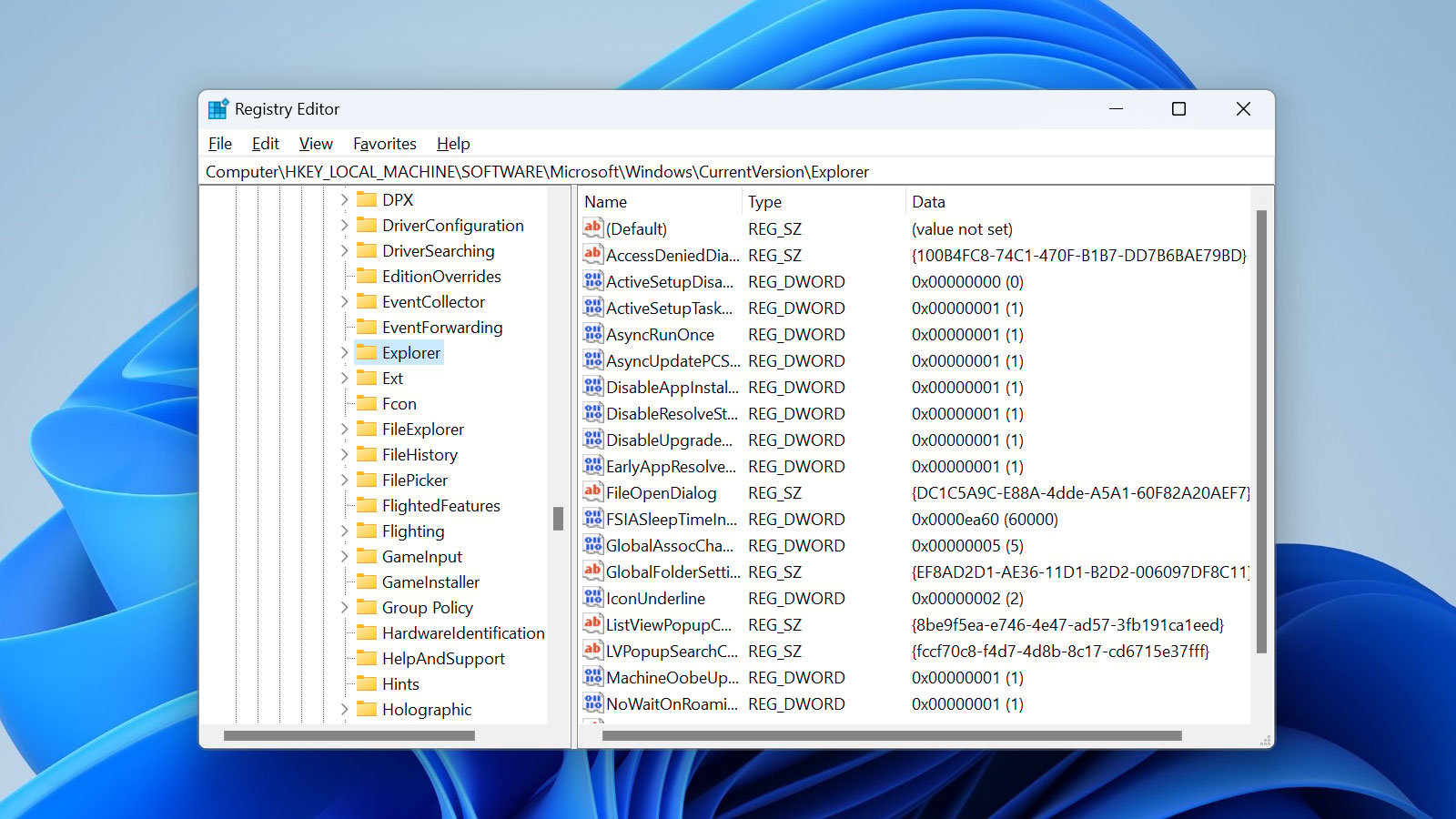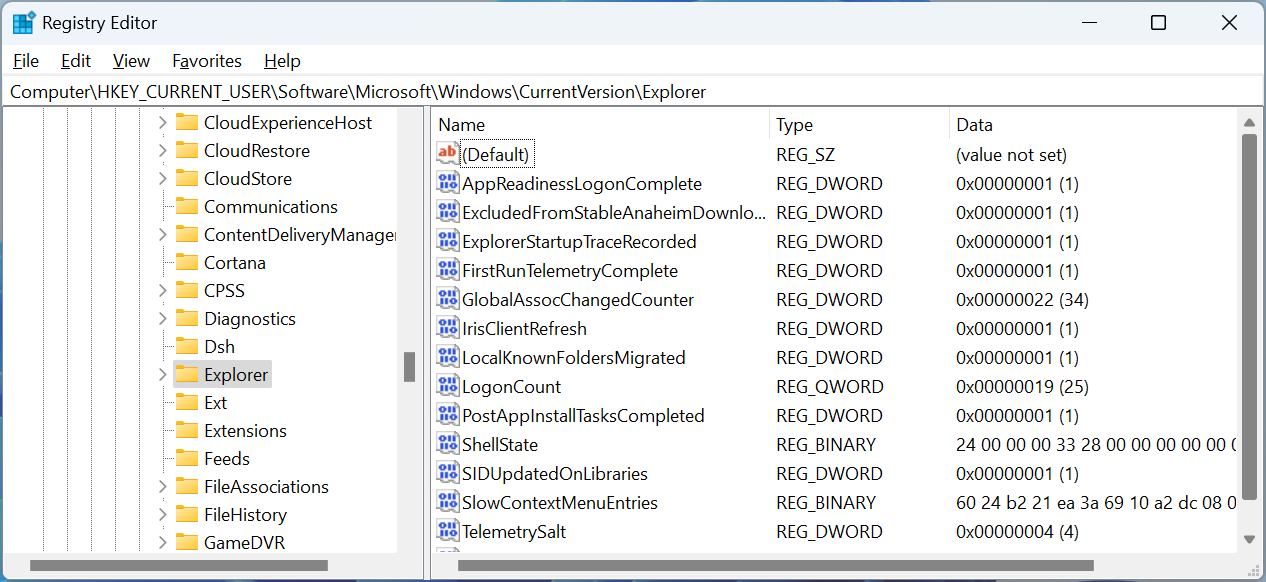How to use the Windows Registry Editor

The Registry Editor allows you to edit and access the Windows configuration settings.
Windows Registry is an application database that contains various settings for the operating system as well as installed software.
It is important to use the Registry Editor with caution, since making the wrong changes can lead to serious issues, such as your system not booting properly.
Before using this guide to change the Windows Registry, please make a copy of the Registry.
Windows Registry – What is it?
Windows Registry is a database that stores configuration settings and options for Windows and any software you have installed.
The Registry is structured in a hierarchical manner, containing both keys and values. There are five ‘root keys’ at the top of the hierarchy, each serving a specific purpose, as shown below.



Various root keys in the Windows registry and their purposes are:
- HKEY_CLASSES_ROOT (HKCR): This key stores information about file associations and OLE object classes.
- HKEY_CURRENT_USER (HKCU): This key stores information about the current user’s settings and a specific user’s preferences for various applications.
- HKEY_LOCAL_MACHINE (HKLM): This key stores information that affects the entire computer, regardless of the logged-in user. These settings are for the computer’s hardware, operating system configuration, and software settings that affect all users.
- HKEY_USERS (HKU): This key stores information about all users who have logged on to the computer.
- HKEY_CURRENT_CONFIG (HKCC): This key stores information about the current hardware configuration of the computer.
You will mostly be modifying values and keys under the HKCU root key and HKLM.
Registry keys can be compared to folders, containing keys and values that are used to group and organize related settings.
HKEY_CURRENT_USER, for example, contains settings related to the current account of the user, including the desktop wallpaper, preferences of installed applications, and personal settings.
Registry values, which are files containing specific settings, are similar to folders. Data types can include text, binary, and numbers.
There are different types of registry values data types.
- REG_SZ – A string value that contains text data, such as a username or folder path.
- REG_DWORD – A numeric value that contains a 32-bit integer.
- REG_QWORD – A numeric value that contains a 64-bit integer.
- REG_BINARY – A value that contains binary data, such as an image or sound file.
- REG_MULTI_SZ – A string value that contains multiple strings separated by null characters. This is often used for lists or arrays of values.
Understanding the different registry values can help you manage and customize Windows better.



When editing the Registry you will most likely be modifying REG_SZ for text data or REG_DWORD values for numeric data. These are the two most common types of data used to store user-editable information.
Administering the Windows Registry Editor
Windows Registry Editor (Windows Registry Editor) is a Microsoft software program that comes with all Windows versions. It allows you to edit data stored in the Registry.
The Registry Editor application is located at C:Windows\regedit.exe, and for the most part, requires administrative privileges to use it properly.
Press the Windows and R keys to open the Run dialogue box. Then, enter ” regedit in the search field and then press Enter. You will be asked if you want to let the program make changes. Select ‘Yes‘.
The Registry Editor window will be divided into two sections. The left pane shows a hierarchical structure of all the Registry keys (folders), subkeys (subfolders), and subkeys.
The right pane shows the values and data that are associated with the key selected in the left pane.



Use the left pane of the window to navigate to a Registry key that you wish to edit. Expand a key by clicking on the plus (+) sign next to it.
Click the minus (-) sign next to a key to collapse it.
The values that are stored in a key will appear in the right pane when you click on it in the left pane.
Let’s now learn how to edit the data that is stored in the Windows Registry.
A new Registry key is Born
You may have to create a new key when configuring Windows Registry settings.
Follow these steps to add a key in the Registry.
- Click on the key in the left pane and right-click to create a subkey.
- Select New-> key.
- Enter the name of the new key, then press Enter.
Building a Registry Key value
It is not uncommon to need to create registry values, as Registry values are the data that controls how an application or Windows functions.
Follow these steps to create Registry values:
- Navigate to the key you wish to add value.
- Select the value type you wish to create by clicking on the key, then selecting ” New“. In the previous section, we explained what types of values you could create.
- Type the name of the new value in the text box.
- Double-click the new value in order to edit it.
- Click OK after entering the desired data.
Another Name For Registry key
You may have to rename Registry values, for example when you introduce a typo.
Please follow these steps to rename Registry keys:
- Click on the key that you wish to rename.
- Select by right-clicking the key.
- In the editable field, enter the new name of the key.
- Click anywhere to save your changes.
Editing Registry value data
Follow these steps to make changes to Registry values:
- Double-click the value that you wish to edit on the right pane.
- Edit dialog box appears.
- Enter the new key value in the field labelled ‘Value Data’.
- Click on OK to save the changes.
Export a Registry key
Registry keys, their subkeys, and their values can be exported to a registry.
Double-clicking on a registry file in Windows will import data into the Registry. Exporting registry keys creates a backup of the Registry before making changes.
- Click the right-click button on the key that you wish to export from the left pane.
- Select and export.
- Select a folder to store the exported key,and give it a unique name.
- Click to Save.
Import a Registry key
You can import a previously exported key into the Registry using the following steps:
- Click on File-> import.
- Locate the export key.
- Click Open to select the key file.
Delete a Registry key
Use the steps below to delete a Registry Key.
- Click the right-click button on the key that you wish to delete.
- Choose ‘Delete” from the context menu.
- Click Yes to confirm that you wish to delete the key.
Note: When you delete a subkey, the values and keys underneath it will also be deleted!
Note: Only delete registry keys if they are not causing problems with your computer.
Delete a Registry value
Use the steps below to delete a Registry Value.
- Click the delete button on the right side of the pane.
- Choose ‘Remove’ from the context menu.
- Click Yes to confirm that you wish to delete the value.
Note: Only delete registry values if they are not causing problems with your computer
You can exit the Registry Editor by clicking the X on the Window, or by clicking File> Exit.
These steps should allow you to use Windows Registry Editor to navigate the Registry and edit it.
It is important to be cautious when changing the Registry. Incorrect changes can lead to severe system problems.
Before making any changes, it is recommended that make a copy of the Registry.
About JNS:
JNS is a Managed IT Services Provider located in Miami, Florida. We deliver Managed IT Services in Miami and throughout South Florida. Delivering full spectrum of infrastructure managed services including managing, hosting, migrating and evolving your environment whether on premises or in the cloud. Call us today at 866-JNS-NETS.
How to use the Windows Registry Editor



The Registry Editor allows you to edit and access the Windows configuration settings.
Windows Registry is an application database that contains various settings for the operating system as well as installed software.
It is important to use the Registry Editor with caution, since making the wrong changes can lead to serious issues, such as your system not booting properly.
Before using this guide to change the Windows Registry, please make a copy of the Registry.
Windows Registry – What is it?
Windows Registry is a database that stores configuration settings and options for Windows and any software you have installed.
The Registry is structured in a hierarchical manner, containing both keys and values. There are five ‘root keys’ at the top of the hierarchy, each serving a specific purpose, as shown below.



Various root keys in the Windows registry and their purposes are:
- HKEY_CLASSES_ROOT (HKCR): This key stores information about file associations and OLE object classes.
- HKEY_CURRENT_USER (HKCU): This key stores information about the current user’s settings and a specific user’s preferences for various applications.
- HKEY_LOCAL_MACHINE (HKLM): This key stores information that affects the entire computer, regardless of the logged-in user. These settings are for the computer’s hardware, operating system configuration, and software settings that affect all users.
- HKEY_USERS (HKU): This key stores information about all users who have logged on to the computer.
- HKEY_CURRENT_CONFIG (HKCC): This key stores information about the current hardware configuration of the computer.
You will mostly be modifying values and keys under the HKCU root key and HKLM.
Registry keys can be compared to folders, containing keys and values that are used to group and organize related settings.
HKEY_CURRENT_USER, for example, contains settings related to the current account of the user, including the desktop wallpaper, preferences of installed applications, and personal settings.
Registry values, which are files containing specific settings, are similar to folders. Data types can include text, binary, and numbers.
There are different types of registry values data types.
- REG_SZ – A string value that contains text data, such as a username or folder path.
- REG_DWORD – A numeric value that contains a 32-bit integer.
- REG_QWORD – A numeric value that contains a 64-bit integer.
- REG_BINARY – A value that contains binary data, such as an image or sound file.
- REG_MULTI_SZ – A string value that contains multiple strings separated by null characters. This is often used for lists or arrays of values.
Understanding the different registry values can help you manage and customize Windows better.



When editing the Registry you will most likely be modifying REG_SZ for text data or REG_DWORD values for numeric data. These are the two most common types of data used to store user-editable information.
Administering the Windows Registry Editor
Windows Registry Editor (Windows Registry Editor) is a Microsoft software program that comes with all Windows versions. It allows you to edit data stored in the Registry.
The Registry Editor application is located at C:Windows\regedit.exe, and for the most part, requires administrative privileges to use it properly.
Press the Windows and R keys to open the Run dialogue box. Then, enter ” regedit in the search field and then press Enter. You will be asked if you want to let the program make changes. Select ‘Yes‘.
The Registry Editor window will be divided into two sections. The left pane shows a hierarchical structure of all the Registry keys (folders), subkeys (subfolders), and subkeys.
The right pane shows the values and data that are associated with the key selected in the left pane.



Use the left pane of the window to navigate to a Registry key that you wish to edit. Expand a key by clicking on the plus (+) sign next to it.
Click the minus (-) sign next to a key to collapse it.
The values that are stored in a key will appear in the right pane when you click on it in the left pane.
Let’s now learn how to edit the data that is stored in the Windows Registry.
A new Registry key is Born
You may have to create a new key when configuring Windows Registry settings.
Follow these steps to add a key in the Registry.
- Click on the key in the left pane and right-click to create a subkey.
- Select New-> key.
- Enter the name of the new key, then press Enter.
Building a Registry Key value
It is not uncommon to need to create registry values, as Registry values are the data that controls how an application or Windows functions.
Follow these steps to create Registry values:
- Navigate to the key you wish to add value.
- Select the value type you wish to create by clicking on the key, then selecting ” New“. In the previous section, we explained what types of values you could create.
- Type the name of the new value in the text box.
- Double-click the new value in order to edit it.
- Click OK after entering the desired data.
Another Name For Registry key
You may have to rename Registry values, for example when you introduce a typo.
Please follow these steps to rename Registry keys:
- Click on the key that you wish to rename.
- Select by right-clicking the key.
- In the editable field, enter the new name of the key.
- Click anywhere to save your changes.
Editing Registry value data
Follow these steps to make changes to Registry values:
- Double-click the value that you wish to edit on the right pane.
- Edit dialog box appears.
- Enter the new key value in the field labelled ‘Value Data’.
- Click on OK to save the changes.
Export a Registry key
Registry keys, their subkeys, and their values can be exported to a registry.
Double-clicking on a registry file in Windows will import data into the Registry. Exporting registry keys creates a backup of the Registry before making changes.
- Click the right-click button on the key that you wish to export from the left pane.
- Select and export.
- Select a folder to store the exported key,and give it a unique name.
- Click to Save.
Import a Registry key
You can import a previously exported key into the Registry using the following steps:
- Click on File-> import.
- Locate the export key.
- Click Open to select the key file.
Delete a Registry key
Use the steps below to delete a Registry Key.
- Click the right-click button on the key that you wish to delete.
- Choose ‘Delete” from the context menu.
- Click Yes to confirm that you wish to delete the key.
Note: When you delete a subkey, the values and keys underneath it will also be deleted!
Note: Only delete registry keys if they are not causing problems with your computer.
Delete a Registry value
Use the steps below to delete a Registry Value.
- Click the delete button on the right side of the pane.
- Choose ‘Remove’ from the context menu.
- Click Yes to confirm that you wish to delete the value.
Note: Only delete registry values if they are not causing problems with your computer
You can exit the Registry Editor by clicking the X on the Window, or by clicking File> Exit.
These steps should allow you to use Windows Registry Editor to navigate the Registry and edit it.
It is important to be cautious when changing the Registry. Incorrect changes can lead to severe system problems.
Before making any changes, it is recommended that make a copy of the Registry.
About JNS:
JNS is a Managed IT Services Provider located in Miami, Florida. We deliver Managed IT Services in Miami and throughout South Florida. Delivering full spectrum of infrastructure managed services including managing, hosting, migrating and evolving your environment whether on premises or in the cloud. Call us today at 866-JNS-NETS.


